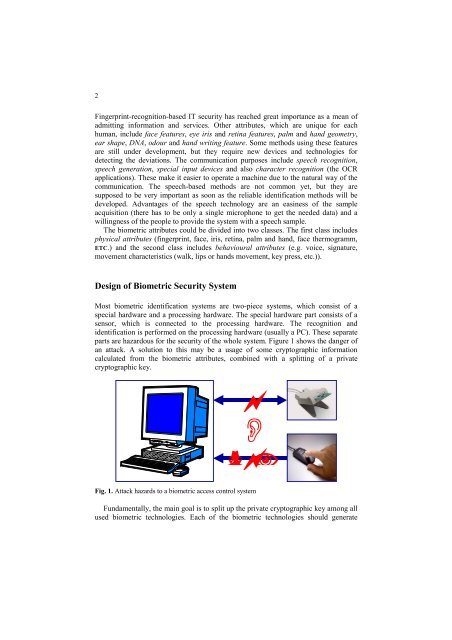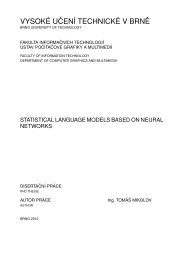Biometric Security Systems: Fingerprint and Speech Technology
Biometric Security Systems: Fingerprint and Speech Technology
Biometric Security Systems: Fingerprint and Speech Technology
Create successful ePaper yourself
Turn your PDF publications into a flip-book with our unique Google optimized e-Paper software.
2<br />
<strong>Fingerprint</strong>-recognition-based IT security has reached great importance as a mean of<br />
admitting information <strong>and</strong> services. Other attributes, which are unique for each<br />
human, include face features, eye iris <strong>and</strong> retina features, palm <strong>and</strong> h<strong>and</strong> geometry,<br />
ear shape, DNA, odour <strong>and</strong> h<strong>and</strong> writing feature. Some methods using these features<br />
are still under development, but they require new devices <strong>and</strong> technologies for<br />
detecting the deviations. The communication purposes include speech recognition,<br />
speech generation, special input devices <strong>and</strong> also character recognition (the OCR<br />
applications). These make it easier to operate a machine due to the natural way of the<br />
communication. The speech-based methods are not common yet, but they are<br />
supposed to be very important as soon as the reliable identification methods will be<br />
developed. Advantages of the speech technology are an easiness of the sample<br />
acquisition (there has to be only a single microphone to get the needed data) <strong>and</strong> a<br />
willingness of the people to provide the system with a speech sample.<br />
The biometric attributes could be divided into two classes. The first class includes<br />
physical attributes (fingerprint, face, iris, retina, palm <strong>and</strong> h<strong>and</strong>, face thermogramm,<br />
ETC.) <strong>and</strong> the second class includes behavioural attributes (e.g. voice, signature,<br />
movement characteristics (walk, lips or h<strong>and</strong>s movement, key press, etc.)).<br />
Design of <strong>Biometric</strong> <strong>Security</strong> System<br />
Most biometric identification systems are two-piece systems, which consist of a<br />
special hardware <strong>and</strong> a processing hardware. The special hardware part consists of a<br />
sensor, which is connected to the processing hardware. The recognition <strong>and</strong><br />
identification is performed on the processing hardware (usually a PC). These separate<br />
parts are hazardous for the security of the whole system. Figure 1 shows the danger of<br />
an attack. A solution to this may be a usage of some cryptographic information<br />
calculated from the biometric attributes, combined with a splitting of a private<br />
cryptographic key.<br />
�<br />
�<br />
��<br />
�<br />
Fig. 1. Attack hazards to a biometric access control system<br />
Fundamentally, the main goal is to split up the private cryptographic key among all<br />
used biometric technologies. Each of the biometric technologies should generate







